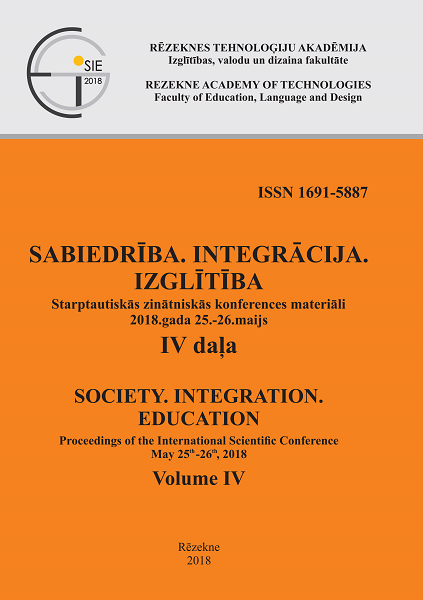RELATIONSHIPS OF PHYSICAL FITNESS TEST RESULTS AND PLAYER PERFORMANCE INDICATORS IN NATIONAL-LEVEL ICE HOCKEY PLAYERS
DOI:
https://doi.org/10.17770/sie2018vol1.3265Keywords:
ice hockey testing, body composition, aerobic fitness, performance indicatorsAbstract
The aim of the study is to identify the relationships of the results of the physiological and anthropometric tests and special on-ice fitness tests with individual player performance indicators during matches of the Poland men's national ice hockey team played during the U18 Ice Hockey World Championship. A total of 20 hockey players (forwards, n=12 and defensemen, n=8) of the Poland men's national ice hockey team were included in this study. All participants were performed a battery tests including maximal aerobic capacity, Wingate test, Repeated-Skate Sprint test and vertical jump test. Pearson correlations were used to examine any differences in all measures and +/– score. Only the fatigue index calculated from the repeated-skate sprint test was significantly correlated with absolute +/– score (r=0.47, p<0.05). The result of the aerobic capacity test, expressed by means of the oxygen intake value (V̇O2max), despite being statistically insignificant, reached the value of r=0.42. The results of this study suggest that game performance as indicated by the +/– score can be predicted by the fatigue index calculated from the repeated-skate sprint test.Downloads
References
Behm, D. G., Wahl, M. J., Button, D. C., Power, K. E., & Anderson, K. G. (2005). Relationship between hockey skating speed and selected performance measures. Journal of Strength and Conditioning Research, 19(2), 326–331.
Bishop, D., Lawrence, S., & Spencer, M. (2003). Predictors of repeated-sprint ability in elite female hockey players. Journal of Science and Medicine in Sport, 6(2), 199–209.
Bracko, M. R., & George, J. D. (2001). Prediction of ice skating performance with off-ice testing in women’s ice hockey players. Journal of Strength and Conditioning Research, 15(1), 116–122.
Buchheit, M., Lefebvre, B., Laursen, P. B., & Ahmaidi, S. (2011). Reliability, usefulness, and validity of the 30-15 Intermittent Ice Test in young elite ice hockey players. Journal of Strength and Conditioning Research, 25(5), 1457–1464.
Burr, J. F., Jamnik, R. K., Baker, J., Macpherson, A., Gledhill, N., & McGuire, E. J. (2008). Relationship of physical fitness test results and hockey playing potential in elite-level ice hockey players. Journal of Strength and Conditioning Research, 22(5), 1535–1543.
Carey, D. G., Drake, M. M., Pliego, G. J., & Raymond, R. L. (2007). Do hockey players need aerobic fitness? Relation between VO2max and fatigue during high-intensity intermittent ice skating. Journal of Strength and Conditioning Research, 21(3), 963–966.
Davis, J. A. (2006). Direct determination of aerobic power. In P. J. Maud & C. Foster (Eds.) (2nd ed., pp. 9–18). Champaign, IL: Human Kinetics.
Diakoumis, K., & Bracko, M. R. (1998). Prediction Of Skating Performance With Off-ice Testing In Deaf Ice Hockey Players. Medicine & Science in Sports & Exercise, 30(5), 272.
Durocher, J. J., Leetun, D. T., & Carter, J. R. (2008). Sport-specific assessment of lactate threshold and aerobic capacity throughout a collegiate hockey season. Applied Physiology, Nutrition, and Metabolism = Physiologie Appliquee, Nutrition et Metabolisme, 33(6), 1165–1171.
Farlinger, C. M., Kruisselbrink, L. D., & Fowles, J. R. (2007a). Relationships to skating performance in competitive hockey players. Journal of Strength and Conditioning Research, 21(3), 915–922.
Farlinger, C. M., Kruisselbrink, L. D., & Fowles, J. R. (2007b). Relationships to skating performance in competitive hockey players. Journal of Strength and Conditioning Research, 21(3), 915–922.
Green, M. R., Pivarnik, J. M., Carrier, D. P., & Womack, C. J. (2006). Relationship between physiological profiles and on-ice performance of a National Collegiate Athletic Association Division I hockey team. Journal of Strength and Conditioning Research, 20(1), 43–46.
McArdle, W. D., Katch, F. I., & Katch, V. L. (2010). Exercise physiology: nutrition, energy, and human performance (7th ed.). Baltimore, MD: Lippincott Williams & Wilkins.
Montgomery, D. L. (1988). Physiology of Ice Hockey. Sports Medicine, 5(2), 99–126.
Peyer, K. L., Pivarnik, J. M., Eisenmann, J. C., & Vorkapich, M. (2011). Physiological characteristics of National Collegiate Athletic Association Division I ice hockey players and their relation to game performance. Journal of Strength and Conditioning Research, 25(5), 1183–1192.
Reed, A., Hansen, H., Cotton, C., Gauthier, R., Jette, M., Thoden, J., & Wenger, H. (1980). Development and validation of an on-ice hockey fitness test [abstract]. Canadian Journal of Applied Sport Sciences, (5), 245.
Roczniok, R., Stanula, A., Gabryś, T., Szmatlan-Gabryś, U., Gołaś, A., & Stastny, P. (2016). Physical fitness and performance of polish ice-hockey players competing at different sports levels. Journal of Human Kinetics, 50(2), 201–208.
Roczniok, R., Stanula, A., Maszczyk, A., Mostowik, A., Kowalczyk, M., & Zając, A. (2016). Physiological, physical and on-ice performance criteria for selection of elite ice hockey teams. Biology of Sport, 33(1), 43–48.
Stanula, A., & Roczniok, R. (2014). Game Intensity Analysis of Elite Adolescent Ice Hockey Players. Journal of Human Kinetics, 44(1), 211–221.
Stanula, A., Roczniok, R., Maszczyk, A., Pietraszewski, P., & Zając, A. (2014). The role of aerobic capacity in high-intensity intermittent efforts in ice-hockey. Biology of Sport, 31(3), 193–195.
Tesch, P. A., & Wright, J. E. (1983). Recovery from short term intense exercise: its relation to capillary supply and blood lactate concentration. European Journal of Applied Physiology and Occupational Physiology, 52(1), 98–103.
Tomlin, D. L., & Wenger, H. a. (2001). The relationship between aerobic fitness and recovery from high intensity intermittent exercise. Sports Medicine (Auckland, N.Z.), 31(1), 1–11.
Vescovi, J. D., Murray, T. M., Fiala, K. a., & VanHeest, J. L. (2006). Off-ice performance and draft status of elite ice hockey players. International Journal of Sports Physiology and Performance, 1(3), 207–221.


